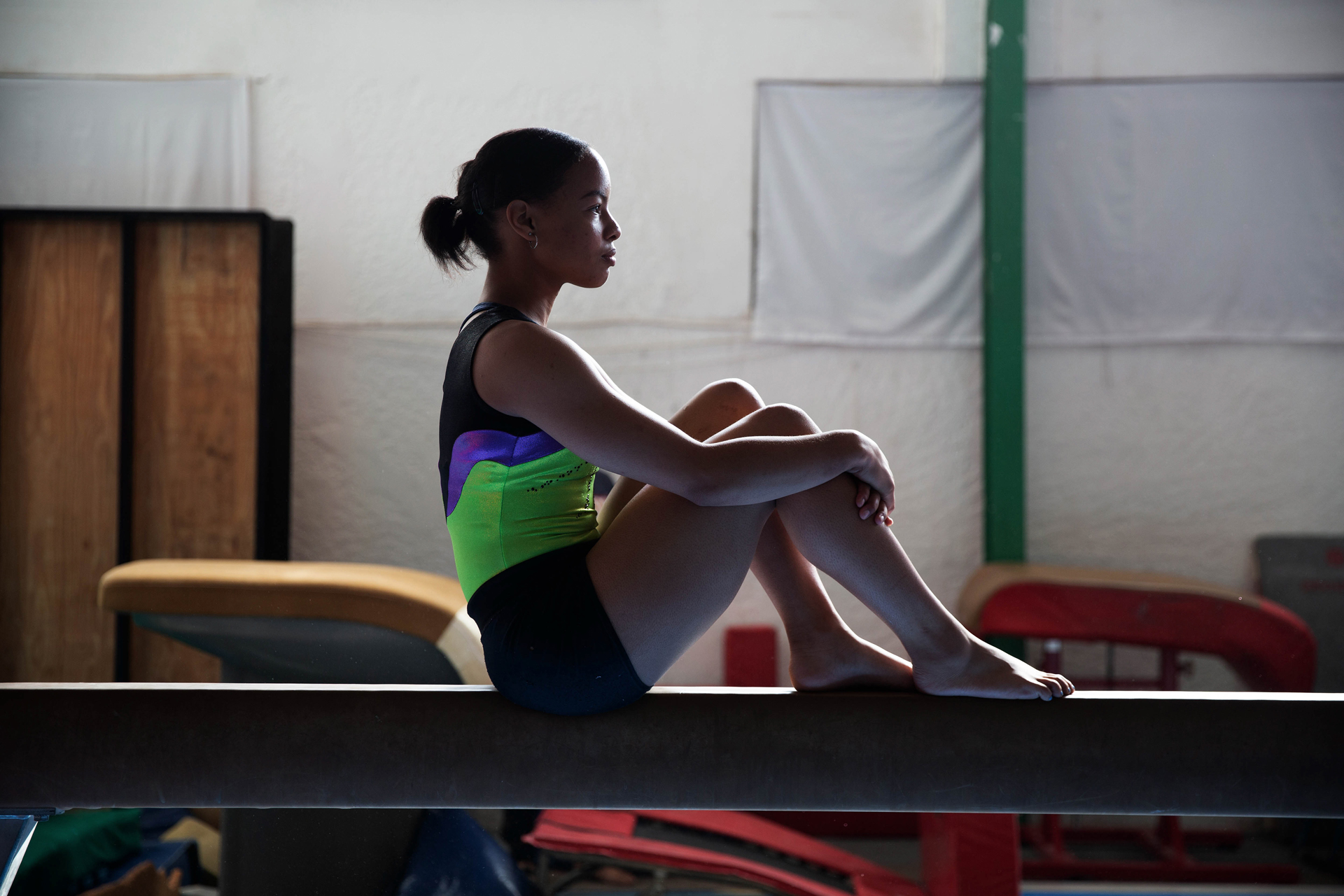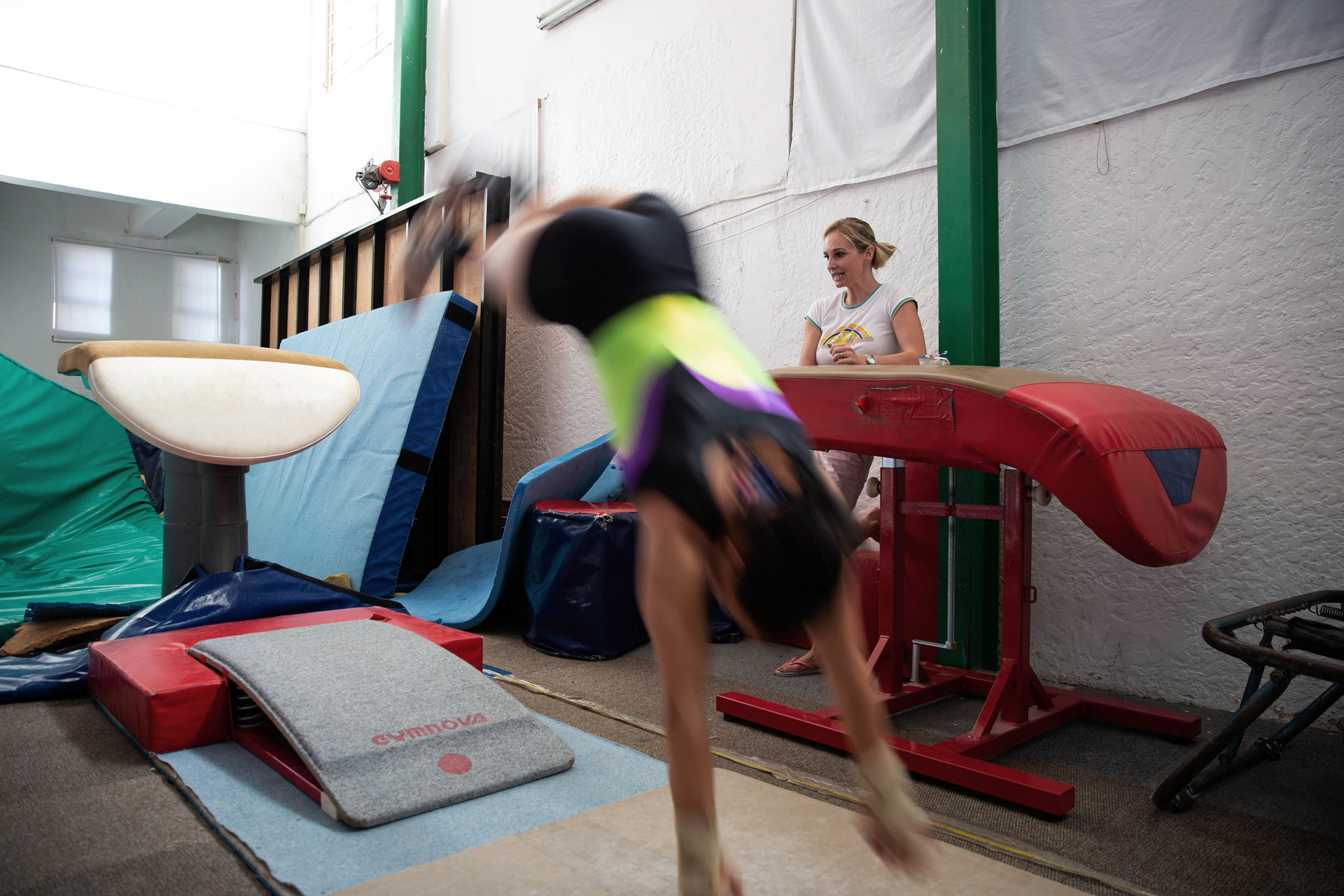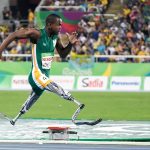Caitlin Rooskrantz inspires a generation of gymnasts
The teenager has made history by becoming the first South African gymnast to qualify for the Olympic Games through an international competition, but she had to defy the odds to book her ticket to T…
Author:
29 November 2019

Dodging a gaggle of fearless five-year-olds flinging themselves into audacious dives on to a large mat, you’d be forgiven for not noticing that there’s an Olympic gymnast in the building. Caitlin Rooskrantz herself has to negotiate her way around the hundreds of little bodies that pack the Johannesburg Gymnastics Centre each day for training.
Every inch of the chaotic building, even the corridors, is used for training space. And somehow they make it work. This jam-packed place has been producing top-class gymnasts for decades. That’s not only down to the hard work that they put in, despite the difficulties, but also to their extraordinary coach, Ilse Pelser.
It’s all a far cry from the pristine facilities Rooskrantz gets to train in for a few weeks a year in Europe, where the state-of-the-art equipment is reserved for the elite. But the passion, commitment and determination to succeed is exactly the same – perhaps even greater among the hungry South Africans, who are aiming not only to excel on the gymnastics front but to gain much-needed exposure and funding for their beloved sport.
That exposure was ramped to new heights in the past six weeks, when Rooskrantz achieved a level of success no South African gymnast has reached before. First up was the FIG World Challenge Cup in Hungary, where her bar routine earned her the gold medal.
“I went into it quite nervous. I didn’t go in with an expectation of getting a medal,” admitted the Parktown Girls matric student. “I had already achieved my goal just by reaching the final. I really just wanted to have fun and enjoy that experience because it’s a big stage you compete on, in a big arena full of people, and it’s broadcast on TV.

“When that score came out, at that point it was the highest score and there was only one more to go, so I knew I was going to medal and I was over the moon. I can’t explain what a big surprise that was for me even. Then the girl after me fell, which meant I had won.”
No South African had ever won gold at an international gymnastics event until that moment.
Then, with confidence sky high, it was on to the World Championships in Stuttgart, Germany, where Olympic qualification was on the line.
Agonising wait for Tokyo
“I went in really confident but I didn’t have the best competition of my life. After I had a fall on beam, it was scary. At that moment it was demotivating because I thought that all my chances were done. But I thought to myself, I can’t throw it away now. I still have three other apparatus, of which one is bar, and I can make it up there. So I really fought to the bitter end and I did a really good bar routine. That’s I think what got me into that spot.”
Having competed on the first day of the two-day competition, an agonising wait followed, trying to figure out if her overall position was high enough to make it into one of the qualifying spots.
Related article:
“It was agony to wait but when that list finally came out with my name on, it was big. I was at home and my coach sent me the screenshot from the international gymnastics body page that they released. I was crying, we all started crying, it was a big moment.”
Considering this is also the first time a South African gymnast has achieved Olympic qualification at a World Championships and not through a continental berth, her coach was also overcome with emotion.
Related article:
“Just ecstatic, you know. Tears of joy. It’s so many years of blood, sweat and tears, literally, that then comes together, and it just makes it worth it, because it’s a lot of sacrifice. Obviously the hard work has just begun though,” said Pelser.
While the thrill of success was huge, it all came at a high price. Rooskrantz does not come from a wealthy background. Her mother, Veda, is a single mom after her husband died 10 years ago, and works at the gym twice a week to try and cover some costs.
Challenges along the way
The Central Gauteng Gymnastics Association and the national body do what they can in terms of support, but then it’s down to jumble sales and cake bakes, raffles and the kindness of others. Not ideal preparation for the greatest sporting spectacle on the planet.
“It’s tough because our challenges are huge. It’s an expensive sport because the equipment only lasts a certain amount of time, and then it actually loses its value and its licences and everything, and you have to replace it,” explained Pelser. “It’s easily R60 000 or R70 000 per piece of equipment. We are a non-profit gym that is really here to serve the community. We just don’t have money. Caitlin definitely has very limited resources and that’s what makes this extra special.”

That’s perhaps why when she achieved what she did, Rooskrantz was quick to point out, this wasn’t just for herself but truly a collective effort.
“It was a really big moment and I was pretty proud, not only for myself but for my coach and for my club and for the country.”
Meanwhile, the other high price that’s been paid for this success is the toll it’s taken on her young body. Only just turned 18, Rooskrantz has been in more doctors’ and specialists’ offices than she’d care to remember. There’ve been many injuries, but the most serious was her knee.
Over the period of two years, she dislocated it five times and finally an orthopaedic surgeon confirmed that she had completely ruptured her medial patellofemoral ligament on the interior side. There was nothing holding her patella down. While they tried everything to avoid it, surgery became inevitable.
“I was out for six to nine months. That was the biggest setback of my career.”
Fuelled by resilience
But with that kind of trial comes a unique kind of mental toughness, just what’s needed in becoming an Olympic gymnast. “I even remember my coach telling me – right after I came out from surgery – that this was going to make or break my career. I could either come back really strong from it or I wouldn’t come back at all, because being out for six to nine months in gymnastics is big.
“We’re off not even for two weeks in December. It’s like a week and a half, that’s our maximum holiday. So six to nine months was not only physically hard but mentally, too. Also, I had to follow strict doctor’s orders. I couldn’t start earlier because then it wouldn’t heal properly and that could jeopardise the rest of my career, so it was a big setback for me but I came back strong. It was really hectic but I had the people around me supporting me really well.

“I was on bed rest for a week after my operation and then, after that, I was on crutches for six weeks and I was here at the gym every single day. Even if it was just for two hours. I couldn’t do anything on my knee but I did a lot of upper body work and visualisation, because I think that’s a big part of our sport is that your mind needs to stay strong.
“I would come in, do some upper body work and then for maybe half an hour, while I iced my knee, I would just sit and watch, like stare at the beam and visualise my routine and try and still stay in it.”
Her coach, who also saw her through the frustration of an ankle injury just before the World Challenge Cup, adds: “That’s why she is just so resilient. I mean that ankle injury could have set her back and she was just like a machine, she did her rehab, lots of physio, platelet injections, just to get through. And the knee surgery, she was off for quite some time as well and made a really strong return after that. She’s a tough, tough gymnast.”
That tenacity seems to be something with which Rooskrantz was born. Her gymnastics story started with driving her parents mad at home.
“I was a very busy child. I could never sit still, I was up and down, trying to climb over walls, inside the door frames, always really putting myself in dangerous situations. My parents didn’t really know how to control my energy and they were quite worried about me. A few of their friends recommended the sport to them, they didn’t even know what gymnastics was then.
“I remember my mom told me the doctor wanted to diagnose me with ADHD and they wanted to put me on meds and stuff and she decided, no, I just need something to channel my energy.”
Inspired by the greatest
That was at age six. At age eight she headed to the Johannesburg Gymnastics Centre and Pelser, and by age 11 she was competing internationally. Seven years later and back in the crowded, and by now steamy hot gym, it’s difficult not to notice the giant words painted on the back wall: “The body achieves what the mind believes.”
It’s a quote from arguably the greatest gymnast of all time, Simone Biles, who recently extended her World Championships haul to a record 25 medals, 19 of them gold. The 22-year-old American provides inspiration for millions around the world, including a young South African star in the making.

“She is incredible on every level you can think of. I have now had the privilege of watching her live for the second time at the World Championships, and competing alongside her. It’s inspiring. You go there and we don’t believe she’s human. She’s a trendsetter in the sport and she’s breaking so many boundaries in and out of the sport for women.”
Rooskrantz got to meet her hero briefly at the recent World Championships, after a special request to the security team that surrounds Biles.
“They are literally celebrities, they walk with bodyguards. It’s really intense, but it was amazing to meet her.”
The contrast between the security-surrounded Americans and the South African team is once again massive. But Biles’ upbringing was far from privileged. It’s the financial resources in a country like the United States that have helped her along the way.

Given the chance to represent another wealthier, better kitted out nation, however, Rooskrantz is quick to respond: “I would be tempted to go, I must say, but I believe I have a lot that I still need to do here in South Africa. Not only for myself but for the sport. I believe that being an ambassador for the sport at this point, I can change a lot.”
Her heart remains in South Africa and at her crazily crowded gym, where the five-year-olds are in awe of their clubmate who’ll soon be jetting off to take on the world in Tokyo, Japan. For Pelser, it’s almost a relief after purchasing the gym at the age of just 21 and trying to inspire young prospects for the past 20 years.
“I think at some point you start wondering if you should be selling the Olympic dream to the gymnasts that walk in here. There are gymnasts here who train six days a week, five hours a day, and you almost think, ‘Am I selling them a lie?’ So this has really made it achievable. Those little kids are very inspired, very motivated, and we’ve got huge talent coming up. So for them, it’s massive.”



